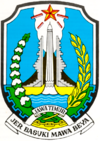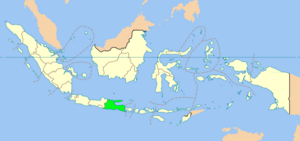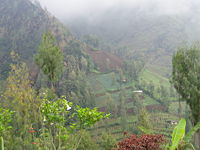East Java
 Motto: Jer Basuki Mawa Béya |
|
 |
|
| Capital | Surabaya |
| Governor | Soekarwo (elected governor) |
| Area | 47,922 km2 (18,503 sq mi) |
| Population | 34,766,000 (2000) |
| Density | 725.5 /km² (1,879 /sq mi) |
| Ethnic groups | Javanese (79%), Madurese (18%), Osing (1%), Chinese (1%) [1] |
| Religion | Islam (96.3%), Christianity (2.6%), Hinduism (0.6%), Buddhism (0.4%), Kejawen also practised |
| Languages | Javanese, Madurese, Indonesian |
| Time zone | WIB (UTC+7) |
| Web site | [1] |
East Java (Indonesian: Jawa Timur) is a province of Indonesia. It is located on the eastern part of the island of Java and also includes neighboring Madura and Bawean islands. The administrative center of the province is located in Surabaya, the second largest city in Indonesia and a major industrial center and port.
Contents |
Population
According to the 2000 census, East Java has 34 million inhabitants, second only to West Java among Indonesian provinces. The inhabitants consist of mostly Javanese. Native minorities include migrants from nearby Madura, and distinct Javanese ethnicities such as the Tengger people in Bromo, the Samin and the Osing people in Banyuwangi. East Java also hosts a significant population of other ethnic groups, such as Chinese, Indians, and Arabs. In addition to the national language, Indonesian, they also speak Javanese. Javanese spoken in the western part of East Java is indistinguishable from the one spoken in nearby Central Java, with its hierarchy of high, medium, and low speeches. But in the eastern cities of Surabaya, Malang, and surrounding areas, the people speak a more egalitarian version of Javanese, with much less regard for hierarchy and a richer vocabulary for vulgarity.
While Madurese is spoken by around 15 millions of Madurese, concentrated in Madura Island, Kangean Islands, Masalembu Islands, Eastern part of East Java, and East Java main cities.
Religion
The main religion used to be Hinduism and Buddhism. With the arrival of Islam, Hinduism was gradually pushed out in the 14th and 15th century. The last nobles and remainders of the fallen empire of Majapahit fled from this point to Bali. This comes from earlier history, when Islam spread from northern cities in Java where many traders from Gujarat, India visited, bringing Islam. The eastern part of East Java, from Surabaya to Pasuruan, then following various cities along the coast line, and turning back in Banyuwangi to Jember, is well known as the "horseshoe area" in context with earlier Muslim communities living there.
Nevertheless, pockets of Hinduism have survived and abangan, the syncretic religion of Islam, Hinduism and Animism, remains strong. See Hinduism in Java for more information.
Administrative areas
- See also: Subdivisions of Indonesia
East Java is administratively divided into 29 regencies (or kabupaten) and 9 cities (or kotamadya).
Regencies (seat):
- Bangkalan Regency (Bangkalan)
- Banyuwangi
- Blitar
- Bojonegoro
- Bondowoso
- Gresik
- Jember
- Jombang
- Kediri
- Lamongan, Lumajang
- Madiun
- Magetan
- Malang
- Mojokerto
- Nganjuk
- Ngawi
- Pacitan
- Pamekasan
- Pasuruan
- Ponorogo
- Probolinggo
- Sampang
- Sidoarjo
- Situbondo
- Sumenep
- Trenggalek
- Tuban
- Tulungagung
Cities:
- Batu
- Blitar
- Kediri
- Madiun
- Malang
- Mojokerto
- Pasuruan
- Probolinggo
- Surabaya
History
East Java's history dates back to the famous ancient kingdoms of Kediri and Singhasari, which is now a city near Malang. The Majapahit empire, centered at Trowulan, Mojokerto East Java, is celebrated by Indonesians as the golden age of the archipelago. The Eastern Java region was the part of the Mataram kingdom during its peak.

Natural resources
- Chalk (Trenggalek & Gresik the city is also famous of its cement industries.)
- Marble (Tulung Agung)
- Oil (Cepu)
- Salt (Madura Island)
Education

East Java hosts some of the famous universities in Indonesia, both owned by government and private. Three major cities for universities, because they have government's universities, are Surabaya, Malang, and Jember. Among them, Airlangga University and Institut Teknologi Sepuluh Nopember are the most famous, and both are located in Surabaya. See: List of universities in East Java
Another important form of education that is available in most cities in East Java is the pesantren. This kind of education is built and organized by Islamic clerics, and associated with local or national Muslim organizations. Jombang is a famous city for its pesantren.
Media
East Java supports several regional media outlets. Local newspapers with provincial news reach their readers earlier than their competitors from Jakarta. In the spirit of "providing more news from around readers", most newspapers even issue municipal sections which are different among their distribution areas.
- Jawa Pos Group, one of major newspaper group in Indonesia, is based in Surabaya.
- Surabaya Post is one of the historical newspapers that had provincial circulation.
- Surya, is one newspaper in East Java, is based in Surabaya. Surya is now under Kompas one of major newspaper group Indonesia
In addition, there are two popular Javanese magazines published in Surabaya:
- Penyebar Semangat (Spreader of Spirit) is a historical and popular Javanese magazine.
- Jaya Baya, a Javanese magazine which used the name of one of the famous Prabu Jaya Baya.
There are also some local television networks which bloomed up since 3 or 2 years ago. The first one is "JTV" from Surabaya. Several more existed and concentrated in Malang areas:
- Batu TV
- Agropolitan TV (ATV)
- Malang TV
- Mahameru TV
- PASTV
National parks

- Meru Betiri National Park - Between Jember and Banyuwangi districts, this park covers 580 km2 (224 sq mi). Hard to get to, it contains fantastic coastal rainforest and scenery and is home to abundant wildlife.
- Alas Purwo National Park - This 434 km2 (168 sq mi) park is formed by the Blambangan Peninsula (south eastern Java). Comprised of mangrove, savanna, lowland monsoon forests and excellent beaches, the park's name means First Forest in Javanese. Javanese legend says that the earth first emerged from the ocean here.
- Baluran National Park - This 250 km2 (97 sq mi) national park is located in north east Java, once known as Indonesia's little piece of Africa, the parks formerly extensive savanna has been largely replaced by Acacia.
- Mount Bromo and Tengger caldera, Semeru National Park, (alt 2500 m); located in East Java at the region of Probolinggo and Pasuruan, 70 km (43 mi) from Surabaya the capital city of East Java province. Mount Bromo is one of the great hiking and trekking destinations for overseas tourists. The breathtaking view of Bromo also attracts hundreds of photo enthusiasts to see the views there.
References
- ↑ Indonesia's Population: Ethnicity and Religion in a Changing Political Landscape. Institute of Southeast Asian Studies. 2003.
External links
- (Indonesian) Official website
- East Java travel guide from Wikitravel
|
||||||||
|
||||||||||||||||||||||
